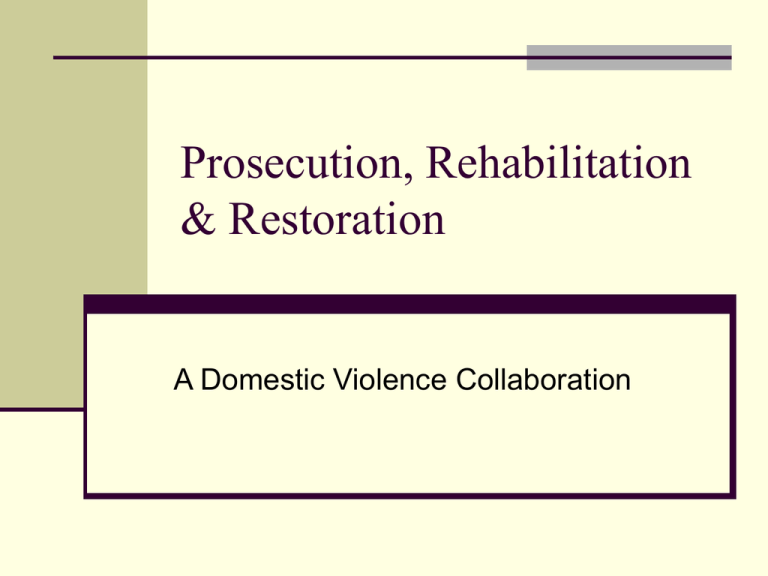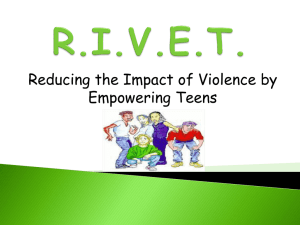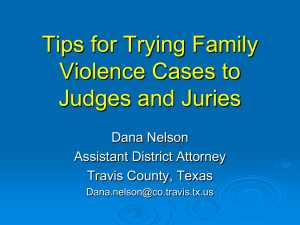APDomesticViolence - Summit County Court of Common Pleas
advertisement

Prosecution, Rehabilitation & Restoration A Domestic Violence Collaboration Presenters John Mascolo Director, Domestic Violence Unit, Summit County Prosecutor’s Office mascolo@prosecutor.summitoh.net David Siko Senior Probation Officer, Domestic Violence Unit, Summit County Adult Probation Department dsiko@cpcourt.summitoh.net Lauren Bartholet Victim Advocate, Victim Assistance Program lbartholet@victimassistanceprogram.org Presenters Kim Subotin Victim Advocate, Summit County Prosecutor’s Office subotin@prosecutor.summitoh.net Special thanks to Holly Johnston. Who are you? History of Collaboration: DVU/SAFE 2004: Creation of DVU/SAFE New staff focused on felony Intimate-Partner Violence Summit County Prosecutor’s Office Re-organized grand jury process; developed “Domestic Violence Day” New prosecutors handled select cases and supervised courtroom prosecutors regarding protocol for intimate partner domestic violence cases Protocol developed for evidence-based prosecution of intimate partner domestic violence in office. 1.5 prosecutors 1 investigator Battered Women’s Shelter—victim advocate Victim Assistance Program: victim advocate History of Collaboration: DVU/SAFE 2006: Expansion of DVU/SAFE 2.5 prosecutors, 1 investigator, 2.5 victim advocates, 1 probation officer, .5 secretary Including 1 Prosecutor trying cases full time Supervisor for Unit Administrative Specialist Probation Specialist Coordinated with Victim Services History of Collaboration: DVU/SAFE 2007: Moving Towards the Future 4 prosecutors full-time 2 on DOJ grants, 2 paid by Summit County 1 investigator (DOJ grants) 2 victim advocates (DOJ grants) 1 probation officer (DOJ grant) Supervising and administrative functions no longer grant-funded. 2008 Domestic Violence Training Project Coordinator 2 part-time Dynamics of Domestic Violence Domestic Violence is a pattern of abusive or coercive behavior used to control an intimate partner Physical Sexual abuse/violence Psychological/emotional abuse Verbal abuse Information courtesy of the Office of State and Local Training at the Federal Law Enforcement Training Center’s Domestic Violence Instructor Training Program Dynamics of Domestic Violence Victim is forced to change her behavior in response to the abuse Occurs in current or former dating, married or cohabiting relationships of heterosexuals, gay, lesbian, bisexual and transgendered individuals. Information courtesy of the Office of State and Local Training at the Federal Law Enforcement Training Center’s Domestic Violence Instructor Training Program Common Battering Perceptions (Excuses) Victims behavior Illness Genetics Cultural norms Alcohol Stress Learned Behavior Anger management Family Issue It’s her fault Information courtesy of the Office of State and Local Training at the Federal Law Enforcement Training Center’s Domestic Violence Instructor Training Program COERCION & THREATS MALE PRIVILEGE ECONOMIC ABUSE INTIMIDATION POWER AND CONTROL USING CHILDREN EMOTIONAL ABUSE ISOLATION MINIMIZING, DENYING & BLAMING Information courtesy of the Office of State and Local Training at the Federal Law Enforcement Training Center’s Domestic Violence Instructor Training Program Barriers to Victim Safety Relentless behavior of batterer Fear of what batterer might do Fear for children or losing custody Financial dependence Conflicts with religious beliefs Isolation and lack of support Information courtesy of the Office of State and Local Training at the Federal Law Enforcement Training Center’s Domestic Violence Instructor Training Program Barriers to Victim Safety Culture Shame (make excuses for batterer’s violence) Immigration status Disability Minimizing the violence Maintaining access to the batterer Information courtesy of the Office of State and Local Training at the Federal Law Enforcement Training Center’s Domestic Violence Instructor Training Program Barriers to Victim Safety Access to shelters LGBT victims Older children Pets Drug and alcohol use Dietary restrictions Limited resources for disabled victims Information courtesy of the Office of State and Local Training at the Federal Law Enforcement Training Center’s Domestic Violence Instructor Training Program How do you talk to a DV Victim Nonjudgmental Allow them to talk Be Patient Be prepared to offer information on finding help if necessary Be truthful Tell them what you can and cannot do Information courtesy of the Office of State and Local Training at the Federal Law Enforcement Training Center’s Domestic Violence Instructor Training Program 6 Things to Say to a DV Victim 1. I am afraid for your safety. 2. I am afraid for the safety of your children. 3. It will only get worse. 4. I am here for you. 5. You don’t deserve to be abused. 6. It is not your fault. Information courtesy of the Office of State and Local Training at the Federal Law Enforcement Training Center’s Domestic Violence Instructor Training Program Diversity Considerations Batterers may use cultural beliefs to control their victims Batterers may use officers’ and advocates’ personal biases to manipulate Information courtesy of the Office of State and Local Training at the Federal Law Enforcement Training Center’s Domestic Violence Instructor Training Program Lethality Indicators Threats of homicide or suicide Fantasies of homicide or suicide Weapons Ownership of victim Victim is pregnant Harming or killing pets Information courtesy of the Office of State and Local Training at the Federal Law Enforcement Training Center’s Domestic Violence Instructor Training Program Lethality Indicators Obsessed with the victim and family Depression/mental illness Access to the victim and/or family Hostage taking Escalation of batterer risk-taking Information courtesy of the Office of State and Local Training at the Federal Law Enforcement Training Center’s Domestic Violence Instructor Training Program Dangers & Risk Indicators Prior contacts with law enforcement Pregnancy Drug and alcohol consumption Increase in frequency and severity of abuse Strangulation Battering during pregnancy Cruelty to pets/damage to property Violence towards children Information courtesy of the Office of State and Local Training at the Federal Law Enforcement Training Center’s Domestic Violence Instructor Training Program Evidence-Based Prosecution of Domestic Violence Evidence-Based Prosecution of Domestic Violence Many times, victims are pressured not to participate in the prosecution. Enhanced investigations allow the prosecution not to rely solely on the victim’s testimony. New paradigm: The goal of a domestic violence investigation is to NOT need victim testimony. (Think Homicide cases) Information courtesy of the Office of State and Local Training at the Federal Law Enforcement Training Center’s Domestic Violence Instructor Training Program Photographs Law enforcement is instructed that there is always a crime scene Photos document injuries, the crime scene, and more. Evidence Guns Weapons Statements Jail calls 911 calls Strangulation Evidence Medical & Hospital Records Expert testimony Medical, injury-focused Battered Person Syndrome In Ohio, see State v. Haines (2006),112 Ohio St.3d 393 Children & Violence (Male in background): “Don’t call 911!” Little girl: “My mom’s boyfriend is hurting my mom…” 911 operator: “Somebody’s what?” Little girl: “Hurting my mom –” 2nd 911 call (Female): “My kids are gonna see this!” Little girl: “My mom’s boyfriend-” Child Witnesses Children should be interviewed Children of violence do not learn boundaries Violence creates constant anxiety and a violent home means feeling powerless Battering creates low self-esteem Children SEE and HEAR violence Referral to ‘Children Who Witness Violence’ Protection Orders NOTICE TO DEFENDANT: ONLY THE COURT CAN CHANGE THIS ORDER. THE COMPLAINANT/VICTIM CANNOT GIVE YOU LEGAL PERMISSION TO CHANGE THIS ORDER... Therefore, if the Victim cannot give the Defendant legal permission to change the Protection Order, then neither can law enforcement. Types of Protection Orders Protection Orders are not merely “no contact” orders. TPOs and CPOs go well beyond an order to have “no contact.” In fact, a person can violate a Protection Order simply by abusing alcohol or drugs; read the Order. Protection Orders If there is a trespass in the Victim’s home by force, stealth or deception, there should also be a charge of Burglary considered. Force, stealth, or deception + enter or remain + without privilege = Burglary The TPO or CPO removes any former privilege to enter the Victim’s home. Our Work with Protection Orders Attempting to bring consistency to Orders of Protection When they are issued When they are withdrawn Roles Prosecution: Center on need to prevent further victimization Victim Advocate: Represents the will of the victim Probation: Dealing with the reports of violations Defendants & The Cycle of Violence We want the defendant to get help Batterers’ Intervention Program (6 month minimum) Mental health expert Drug and/or alcohol counseling Can be an opening for change But don’t be naïve Chosen conduct Many do not want to change Antisocial or Oppositional Probation History Unit started in 12/2005 Another draftee Fresh Slate Constant growth Who is supervised? No one needs to reinvent the wheel Ann Crowe—APPA Dr. Andrew Klein Duluth Project Probation Structure Specialist officer Domestic Violence Felony Three (Violation of Protection Order) Menacing by Stalking NO PSI writer What is your agency structure? Supervision Tools Supervision tools Questionnaire Special Rules Definition of Offensive Conduct Intimate Partner Disclosure Supervision Tools Learning a new language to paint an accurate picture. Good citizen vs Picture of violence Include the Children Supervision Tools Many victims will report they have been “choked” when in technical terms they were the victims of strangulation. Choking = an internal obstruction of the airway. Strangulation = a form of asphyxia characterized by closure of the blood vessels and air passages of the neck as a result of external pressures on the neck. Recent development of strangulation offense in several states Information courtesy of the Office of State and Local Training at the Federal Law Enforcement Training Center’s Domestic Violence Instructor Training Program Video Relationships Between Prosecutors, Probation and Advocates Follow case from beginning Be made aware of cases that do not fit protocol Provide prosecutors with understanding of probation actions Provide information to PSI writers from prosecutors Monthly in-service meetings of collaborative staff Victim Advocates & Probation A conduit for the victim Contact information for the victim Sharing the burden of obsessive victims Help determine validity of complaints Challenges Statistics Additional Meetings Additional Training Officer Resistance Time Consuming Cases Not always on the same page Traditional view Modern view Burnout Solutions With victim services Expert testifying Domestic Violence Nurse Examiner (DVNE) Services Victim advocates present at meeting with prosecutor With probation Clarence Fry case Before collaboration with probation Emphasize need for police and judicial training Solutions With Prosecutors Consistent theme of victim safety and offender accountability should guide evidence-based prosecution of domestic violence Seek PSI with all offenders Gives court and probation more knowledge so sentencing decision is better-informed Consider mental health assessment and drug/alcohol assessment as part of each PSI if possible Use Lethality Assessment tool; do not rely solely on victim’s statement for determination of victim’s safety Provides offenders opportunity to show remorse and articulate the wrongfulness of their offense (or not). Why Does Collaboration Work Everyone does job with more information, not less “It takes a village” mentality Improved sentencing recommendations Main objective is to hold violent offenders accountable and keep victims safe Intervention in the cycle of violence is a good thing Thank You for Your Support Summit County Prosecutor Sherri Bevan Walsh Rev. Robert Denton-Victim Assistance Program Terri Heckman-Battered Woman’s Shelter Summit County Court of Common Pleas Honorable Elinore Marsh Stormer – Administrative Judge Honorable Paul J. Gallagher— Presiding Judge








